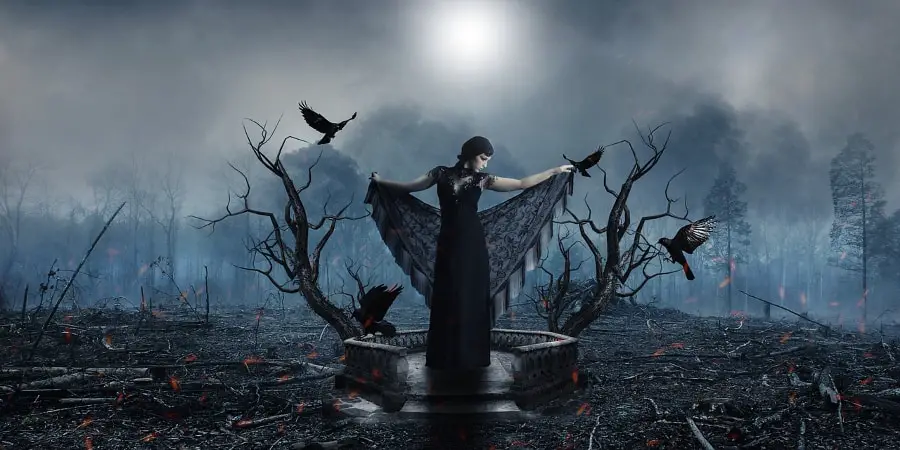One of the interesting entities as far as Norse mythology is concerned is certainly the goddess named Hel, The ruler of the underworld also known as Hel.
Hel was said to be one of Lokis’ children who wielded great power. Due to this fact, she was appointed by Odin to Rule over the realm bearing her own name in Niflheim, where she would receive the portion of the head succumbing to sickness and old age.
In this article, we will take a look at this interesting deity in Norse mythology who was the inspiration for the villain Hela in the Marvel movie “Thor: Ragnarok”.

Who was Hel?
Even though Hel was the undisputed ruler of the underworld she is very different from Satan in Christianity. This is because unlike Satan she is never portrayed as entirely evil.
According to Norse mythology, She was the child of Loki, the god of mischief, and the jötunn giantess Angrboda, the mother of monsters.
Because of the considerable strength of Lokis children they were sent to places where they could do as little harm as possible. Therefore, Hel was appointed by Odin to be sent to Niflheim, one of the Norse lands of the dead.
Here was to have her kingdom bearing the same name as herself where she was responsible to take care of the souls who died of old age and sickness who ended up in her realm.
In one of the Norse Sagas, she is described as being half black and half flesh-colored, which some scholars have interpreted as her being half living being and half corpse. Hel is also said to have had a downcast and fearsome look.
It goes on to describe how she eats from a dish called “hunger”, with a knife called “famine”, suggesting that no amount of eating can fill the empty stomachs of the dead.
From the sagas, the events surrounding the death of the god Baldr suggest that Hel has the ability to bring the souls she has in her realm back to life by releasing them from her realm.
Family
In the important Norse saga, Prose Edda, she is said to be the daughter of Loki and Angrboda, a jötun giantess and the mother of monsters.
This made her the sister of Jormungandr, the Midgard Serpent, and the sister of Fenrir, the mighty Norse wolf. No mention is made in any of the ancient works of any offspring for Hel.
Mythology
Hel is mentioned in several ancient works such as Poetic Edda dating from the 13th century and also in Egils Saga and Heimskringla dating from the 9th and 10th centuries.
There is also a portion of Gesta Danorum which has been written by Saxo Grammaticus in the 12th century which seems to allude to Hel, in addition to brief mentions in other works.
In Gylfaginning, the second section of Prose Edda, Hel is said to have dominion over a large number of servants living in huge mansions all of which are part of her underworld realm.
It goes on to tell the story of how Hel played an important role in the later attempt to resurrect the god Baldr, the son of Odin and Frigg.
After Balder was killed due to the actions of Loki. The god Hermod volunteers to travel to Hel in order to talk her into releasing Baldr. The story goes on to tell how Hel agrees on one condition; that all things in the world, alive or dead, weep for the loss of Baldr.
The gods are almost successful as everyone and everything does, except for a Jötunn thought to be Loki in disguise, forcing Baldr to remain with Hel.
A lot of research has been conducted over the last couple of decades and there has been speculation about a potential connection between Hel and other historic figures which are mentioned in the 11th-century old English Gospel of Nicodemus.
There are also portions in the Old Norse Bartholomeus saga, postola, which seems to suggest that she could have been a goddess similar to other Hindu deities such as Mahakali, Kali, and Bhavani.
How important was Hel?
Little is known about the importance of Hel in the everyday life of the Vikings. However, Heimskringla mentions Kings dying from sickness and accidents as being taken by Hel.
This might suggest that being taken by Hel was a reference to death from other causes than falling in combat as something undesirable and to be feared.
This is largely due to the prominent belief that a violent death in combat earned your place in Valhall, Odin’s great hall where all the slain warriors would be gathered to feast and fight.
While there have been some bracelets and medallions depicting what is suggested to be Hel, there is no way of knowing whether Hel was considered a goddess that was paid homage to or not.
In fact, some scholars suggest that she was not considered a Goddess at all, that “Hel” referred to the grave as a place rather than an entity, and that the personification of Hel came later.
In popular culture
Despite Hel not playing a significant role in Norse mythology as a whole, she had a very prominent role in the Marvel universe.
In the Marvel movie “Thor: Ragnarok”. Hel was featured as the main villain. In it, she goes by the name of Hela, and in addition to the name change, the moviemakers took several creative liberties.
In the sagas, Hel was the daughter of Loki but in the movie, she is the daughter of Odin. Instead of being sent to Niflheim because she was too powerful, the movie tells the story of how Hela was cast out by Odin because of her driving ambition in their quest to conquer the universe.
Another interesting fact is that it is deemed inappropriate to name girls Hel by the naming committee in Iceland, a country with the deepest ties to Norse culture, reasoning that it can cause the child significant distress and trouble as it grows up.
